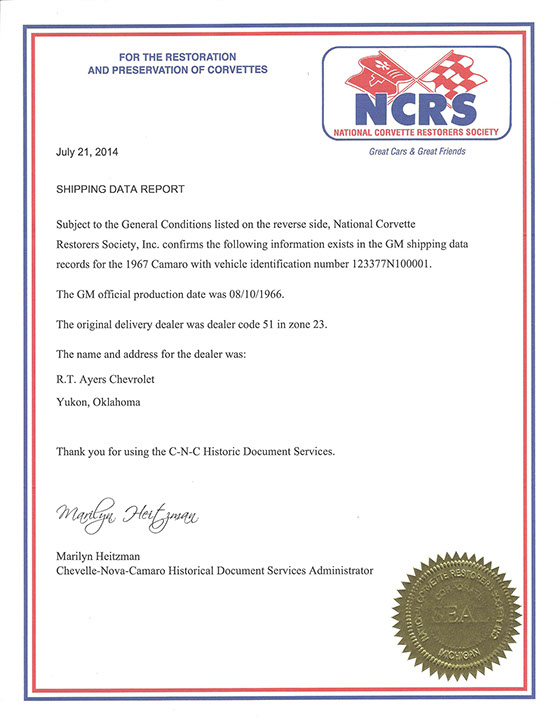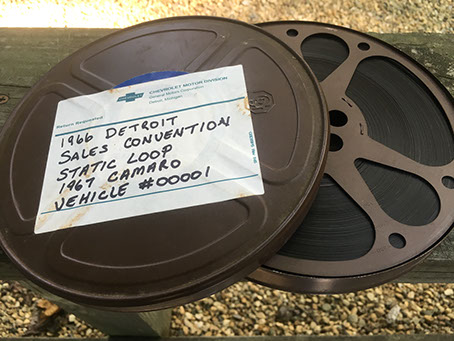
Next Pilot

"The 6-Cylinder Detroit Convention Unveil Car"
Norwood
"F" Car Pre-Production Unit
Fleet & Special Order 5 - 10
Sales - Convention Detroit
Model - 12337
Body Style - Sport Coupe
Serial # 12337
Fisher # DD01D
Paint # 900GG Granada Gold - Show Paint Required
Trim # 709AB Gold
Options
Standard - L/6 230 cu. in. Engine
Standard - 3 Speed Transmission
P01AA - Wheel Discs
P58AA - 7 : 35 - 14 - 4 W/Wall Tires (Firestone)
U63AA - Push Button Radio
Front Antenna
110 Volt Wiring
A39AH - Deluxe Seat Belts
Fisher Pilot Plant # 21 - Detroit
Fisher Promise Delivered To Chevrolet - 5/21
Vehicle Required At Destination - 8/1
Destination - 6030 Cass Ave.
Detroit, Michigan
Attention: D. Reeves
Final Destination - Kansas City, Missouri


Vintage Pilot Book Page
Click The Image To Read
N100001 Videos

50 Year History of #1
Built in secret, Fisher Body began work on #123377N100001 on May 17, 1966. The coach was delivered to Chevrolet by Fisher Body on May 21, 1966, and the final assembly work then began on the first “F” car to be produced in the Norwood Pilot Prototype Production car program. N100001 is the very first build of the hand-built, 49 car Pilot Prototype assembly test program designated for the GM Norwood, Ohio Assembly plant. The first “F” car to be produced in an assembly plant was produced and configured with a 230 cubic inch engine, 3-speed transmission, whitewall tires, push button radio, front antenna, and deluxe seat belts. Built for the product launch with “show paint required,” it was lightly equipped to accommodate the opening days of the Pilot Prototype build and also to appeal to the masses in pricing and safety features. It was also equipped with a 110-volt static lighting display to be used at General Motors sales conventions. When it was finished it was stored hidden until its inaugural uses as an assembly test mule and display in the Chevrolet product line unveiling.
(Photos courtesy of Jim Seim and Philip Borris, author of Echoes of Norwood.)












<
>
It was during its time in secretive storage that Pete Estes held a dramatic 10:00 a.m. 14 city network news conference and officially released the name “Camaro” to the world. Up until that moment, all Pilot Prototypes had been built without even knowing a name. The Camaro was received by the automotive press to much enthusiasm and was estimated to account for 12% of Chevrolet production in 1967. N100001 was removed from lock and key and used as an assembly test mule before being required at destination by GM employee D. Reeves at 6030 Cass Avenue in Detroit on August 1, 1966 officially prior to the unveiling of the Camaro on or around August 25, 1966 at the Sheraton-Cadillac Hotel. It was at this convention that R.T. Ayers first saw the sport coupe and used his influence inside the Camaro division to request and receive the initial build from the product unveiling.(Courtesy photos, GM Heritage Museum and personal interview of R.T. Ayers Jr.)










<
>
Full production of the Chevrolet Camaro began on August 7, 1966 at the Norwood plant. It was the engineering knowledge and revisions from the information gleaned during the Pilot Prototype program that made this a smooth transition. Jim Seim, Pilot Program Coordinator, was in charge of making these engineering revisions based upon the feedback he was receiving from the multitude of vendors involved, as well as the pilot program employees.
With the sales convention complete in Detroit for the release of the 1967 Camaro to the Chevrolet dealers of the world, affectionately known as “Men of action”, N100001 was shipped to the Tech Center in Warren, Michigan for a photo shoot that would include press release photos in still photography, as well as, color Jam Handy promotional videos to be used by General Motors. N100001 can be recognized in multiple photographic forms gracing the images with its signature “1967” vanity plates. Curiously, the car appears with and without the single, small block letter emblem used on the deck lids and headers on the front fenders. With no holes drilled for this build, it is thought that these graces were applied with a small amount of double sided tape and removed. Shortly after this shoot, press release photos were circulated across the country to newspapers around September 8, 1966 for the new Camaro roll out at local dealerships for the end of the month of September.
(Courtesy photos, GM Heritage Center, and Kansas City Star Archives)














































<
>
After its appearances at sales conventions in Detroit and Kansas City in the last half of 1966, N100001 was shipped back to Flint, Michigan for removal of the specialized 110 volt static display lighting by GM for reuse and the car was then shipped to R.T. Ayers High Performance Chevrolet in Yukon, Oklahoma in December of 1966. (Jim Seim interview and GM shipping receipts)
R.T. Ayers, recognizing the sales potential of having the first build in his inventory, took delivery in December of 1966. He had become a prominent driving force in the Midwest, selling and specializing in the high performance models of the day. Relocating his family from Kentucky to Yukon, Oklahoma in 1957 and quickly making the transition from nylon design, manufacture, and distribution to the aircraft industry. With the partnership of his brother’s pre-existing car dealership, Yukon Pontiac on his resume, he began his ascent to the top. In late 1959, he convinced upper management at Pontiac to listen to his expertise in seat belt manufacture. His ideas were ultimately implemented years later and a life-long friend in Semon “Bunkie” Knudsen was achieved. Knudsen, with Pete Estes by his side for years became close friends with R.T. Ayers. It was these relationships that drove Ayers to travel extensively and stay in constant touch with the quickly changing landscape. It was because of his relationship with the “inner circle” that R.T. bought the local Chevrolet dealership in 1962. He was aware of the management changes underway and the refocus of the product lines away from Pontiac to Chevrolet. It is not coincidence that Ayers immediately closed the Pontiac dealership and turned his focus to Chevrolet. R.T. Ayers Jr. recalls the evening that his father bought the Chevrolet dealership in impromptu fashion at The Yukon Roundup Club in the summer of 1962 saying, “Dad was listening to Mr. Barrett vent about the trials and tribulations of running the store. Mr. Barrett, drink in hand, voiced that if he could sell the store and retire……he would. My Dad removed his checkbook from his pocket and wrote a $5,000.00 escrow check on the spot.” The family’s relationship with top brass continued for years with R.T. Ayers Jr. sharing correspondence additionally with Bunkie Knudsen.
(Courtesy interview with R.T. Ayers Jr. and documentation)
















<
>
With delivery of N100001 realized in December of 1966, Mr. Ayers used it as a sales tool and it remained on the showroom floor for two years and five months. Recalling the presence of the glory years, R.T. Ayers Jr. said, “Dad always had the coolest stuff. I drove a 435 HP corvette as a demo to high school……..scared the hell out of me.” It was during this time during the muscle car pinnacle that Mr. Ayers and his family gained so much acclaim locally. They were active in philanthropic endeavors and never met a stranger.
The dealership was located on Historic Route 66.
(Courtesy interview and documentation)




<
>
N100001 was sold to the first owner, Linda Johnston of Oklahoma City, two and half years later on April 5, 1969. Paying full sticker of $2550.00 at delivery with no liens, it is clear that she knew the allure of the car. It is thought that there was a family connection between her or her father and the Ayers family, because the two families are buried within 200 feet of one another in the same obscure cemetery outside of Yukon, Oklahoma. Miss Johnston enjoyed the car until December 5, 1975 when the car was sold to a dealer in Frederick, Oklahoma. Linda never married, was never blessed with children, lived her entire life with her parents in the same home,
and is buried with both of her parents at Resurrection Cemetery.
(Courtesy photos and original documentation)














<
>
J.S. Auto Supply of Frederick, Oklahoma took just under three months to sell the car……..again, for full sticker……, the purchase price to the second owner being the same amount that was paid for the car new. It is clear again that both parties knew the significance of VIN number seven years later when delivery was taken. The used car dealership was owned by Jerry Strickland and
Mr. Hatfield until it dissolved years later.
(Courtesy photos and original documentation)






<
>
The second owner, Alvis Harper, purchased the car locally on February 28, 1976 for his son Sam. The 16 year old second owner began driving the car to school his sophomore year and it became a fixture in the small town of Frederick. Understanding the uniqueness of the car, they enjoyed the car together until the untimely death of Sam on August 31, 1982. Alvis, distraught over the loss of his young son, sold N100001 within weeks of his son’s death. With a loss of his only son at the age of 23, the sight of the car was more than he could bear. Alvis passed on January 13, 1998. He was survived by his wife, Sue and daughter, Kathy. The two still reside in Frederick,
Oklahoma and own the Tanglewood Motel together.
(Courtesy photos, original documentation, and interview with Kathy)


















<
>
Al Tepke of Oklahoma City purchased the car from the grieving Mr. Harper in early February of 1982. Al, avid race car aficionado, began disassembly of the car immediately. Understanding the novelty of campaigning the first Camaro, he did so carefully and saved the parts removed in his garage. Al inscribed his name in the original frame when the race trim was added and complete. The car was seen locally and is recognized in pictures at drag strips in NHRA at Amarillo, Green Valley, and Oklahoma City. The car was driven and owned by multiple participants and it is thought that the historical significance of the initial build was lost to the
owners in the late 1980’s when it was put into long term storage.
(Courtesy photos and interview with Tepke)








<
>
Jobin Sims of Norman, Oklahoma purchased the car and its unknown provenance and
significance on February 21, 2009 with the intention to race the car with his two sons locally. Ironically, the car was purchased again……..for approximately the same price as the car was sold initially, $2500.00. He discovered the possible significance of the build when the VIN number was requested by his local home insurance agency. A frenzied research and study began that proved more than the owner could navigate prior to the original Pilot Prototype documentation being discovered during the research and writing of the book, “Echoes of Norwood” by Phil Borris. Jobin, worn down by the economic collapse of 2008-2009, decided to offer the car for sale and use the proceeds to change careers. (Courtesy photos, original documentation, and interview with Jobin Sims)












<
>
While at Norwood, N100001 was used as a chassis side (Chevrolet) assembly test mule as one would expect with the first “F” car produced. Its first and original 230 cubic inch engine, 3-speed transmission, one of the very last items installed in the car, came right out of standard assembly stock for that time with a motor build date of August 3rd, 1966. The date on the original motor was quite a mystery for a short time as the Pilot Prototype data book for N100001 indicated a preference ship date as 8-1-66. Additional research with the NCRS, however, quickly solved this mystery as the NCRS official “production record”(generated directly from the original GM shipping records) list the car with an official production date of 8-10-66, so the delivery date to the initial destination on Cass Avenue in Detroit was delayed by 10 days. A basic understanding of the relationship between the term ”official production date” and the relationship to the shipper date is required. The shipper date was the date when the car was considered “released to the shipper” and all production/repair was technically complete. This date had to be very accurate when the shipper took possession of the product; therefore the official production date designation
simultaneously triggered the release date to the shipper-Complete Auto Transit.










<
>
The restoration process began in late 2012 and finished in May of 2014. Recognizing the monumental gravity of the historic build, no expense was spared with the goal being use of only original GM parts. This was achieved with the exception of one reproduction seat cover and a carpet set. Great length and great expense was tasked to save the original sheet metal and parts to the initial Pilot Prototype build. Recognition is given to Dave Hanna of Sterling Classics for his time and expertise in the restoration process.
(Courtesy photos and interview)


































<
>
Within weeks of the completion of the restoration and with all ownership history procured, the owners reached out to the GM Heritage Center for help uncovering any early factory documentation. With the personal touch of Christo Datini…….an introduction to Phil Borris ensued. Phil and Jim Seim were able to provide early factory documentation of the build, as well as information thought to be lost previously. The car was invited to a local UAW Retirees convention and everyone met personally for the first time. Ceremoniously, the car was unveiled to GM Norwood employees yet again, for the second time as the now restored build, came full circle…
returning to greet the people who built it originally so many years ago.
(Courtesy photos and interview)





























<
>
Update: August 14, 2016

All of the Vehicles produced by the former General Motors Corporation at its long expunged Norwood, Ohio factory are all existing trademarks of the new General Motors Company. Any and all historical marks as used here are used for identification, description, illustrative, and educational purposes only. This site is not affiliated with General Motors Company.
By: Logan Lawson
Registrar Of WWW.PilotCarRegistry.com
Copyright 2014 Logan Lawson. All Rights Reserved.




